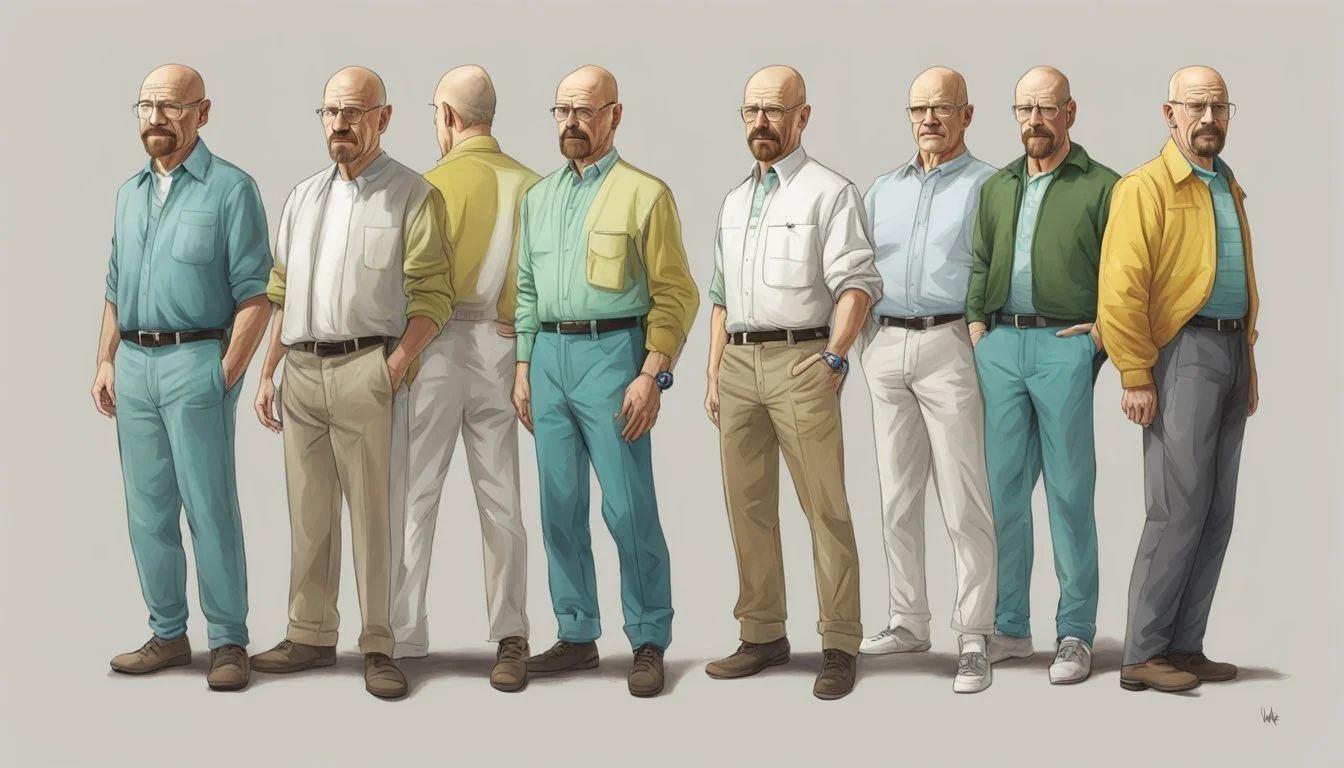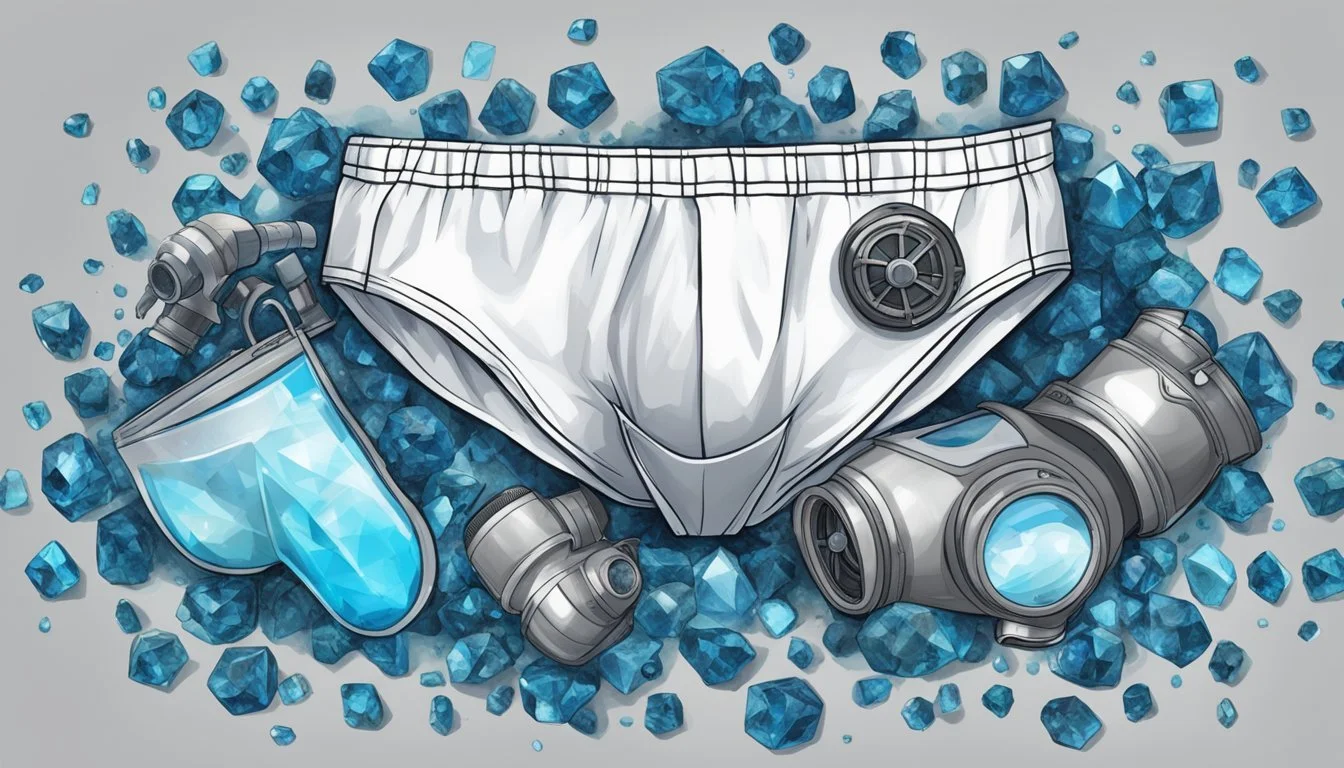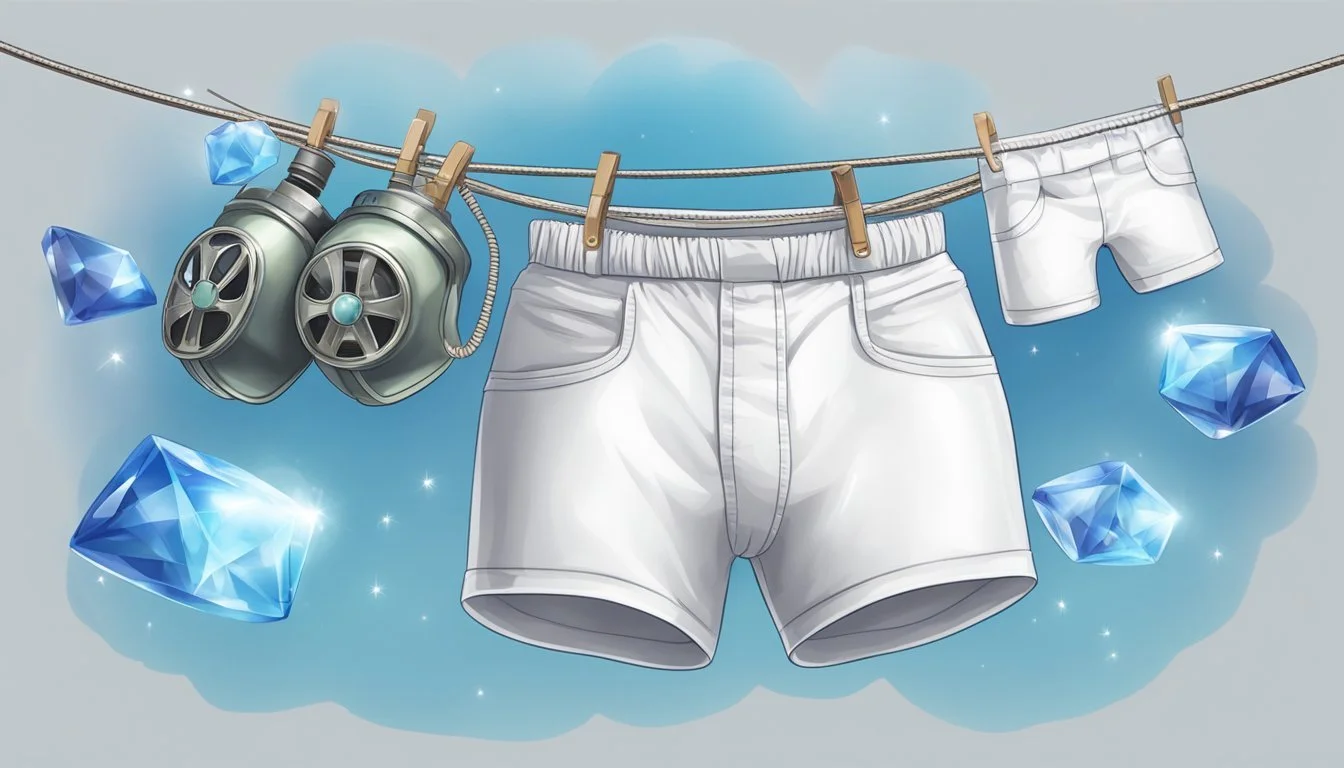Tighty-Whities and Transformation: Iconic Imagery in Breaking Bad
Unpacking Walter White's Journey
Breaking Bad's iconic imagery has left an indelible mark on television history. Among the most memorable visual elements is Walter White's choice of underwear - the humble tighty-whities. These simple white briefs become a powerful symbol throughout the series, representing both vulnerability and transformation.
Walter White's tighty-whities serve as a metaphor for his character arc, from mild-mannered chemistry teacher to ruthless drug lord. As Walter sheds his ordinary life, the underwear remains a constant reminder of his origins and the man he once was. This stark contrast between his initial appearance and his eventual persona as Heisenberg highlights the show's themes of duality and change.
The cultural impact of Walter White's underwear extends beyond the series itself. Fans and critics alike have dissected its significance, cementing the tighty-whities as a key part of Breaking Bad's visual language. This seemingly mundane garment has sparked discussions about identity, power dynamics, and the complexities of human nature, demonstrating how even the simplest objects can carry profound meaning in storytelling.
Breaking Bad: A Cultural Phenomenon
Breaking Bad revolutionized television storytelling and captivated audiences worldwide. The show's innovative narrative and complex characters left an indelible mark on pop culture.
The Rise of Heisenberg
Walter White's transformation into Heisenberg became a cultural touchstone. The mild-mannered chemistry teacher's descent into the criminal underworld resonated with viewers. His iconic look - shaved head, pork pie hat, and dark sunglasses - became instantly recognizable.
Breaking Bad's attention to detail elevated it above typical crime dramas. Props like Walt's tighty whities from the pilot episode became symbolic of his character arc. These items are now displayed in museum exhibits, highlighting their cultural significance.
The show's portrayal of moral ambiguity challenged viewers' perceptions of right and wrong. Heisenberg's catchphrase "I am the one who knocks" entered the lexicon, encapsulating his menacing persona.
The Impact on Television
Breaking Bad raised the bar for television quality and storytelling. Its cinematic visuals and tightly plotted narrative influenced subsequent TV productions. The show proved that cable networks could produce prestige dramas rivaling those of premium channels.
Creator Vince Gilligan's concept of "turning Mr. Chips into Scarface" demonstrated the potential for long-form character development on TV. This approach inspired other series to explore complex character arcs over multiple seasons.
Breaking Bad's success paved the way for more daring and unconventional TV concepts. It showed that audiences were ready for morally ambiguous protagonists and challenging storylines.
Fandom and Legacy
Breaking Bad cultivated a passionate fanbase that remains active years after the show's conclusion. Fans dissect episodes, create theories, and produce fan art celebrating the series. The show's popularity led to successful spin-offs like Better Call Saul, expanding its universe.
Breaking Bad merchandise ranges from blue candy "meth" to Heisenberg t-shirts, demonstrating its enduring appeal. The show's locations in Albuquerque became tourist attractions, boosting the local economy.
The series continues to attract new viewers through streaming platforms. Its themes of power, morality, and consequences resonate with audiences across generations. Breaking Bad's legacy as a television masterpiece seems secure for years to come.
Character Study: Walter White's Metamorphosis
Walter White's journey from a mild-mannered chemistry teacher to the notorious drug lord Heisenberg is one of television's most compelling character arcs. His transformation touches on psychological, moral, and relational aspects that define the series.
Walter White to Heisenberg
Walter White begins as an underachieving high school chemistry teacher struggling to make ends meet. His cancer diagnosis catalyzes a radical shift in his priorities and actions. As he delves into the meth business, Walt adopts the alias "Heisenberg," inspired by the German physicist.
This new persona allows Walt to separate his criminal activities from his family life. He grows increasingly ruthless and calculating, willing to manipulate and eliminate anyone who stands in his way.
Walt's signature look evolves from meek suburban dad to intimidating kingpin. He shaves his head, grows a goatee, and trades his beige wardrobe for dark colors and the iconic pork pie hat.
Psychological Transformation
Walt's psychological change is marked by growing pride, ambition, and a thirst for power. Initially motivated by providing for his family, he soon craves recognition and respect.
His moral compass deteriorates as he rationalizes increasingly unethical actions. Walt becomes more willing to lie, cheat, and kill to protect his interests and empire.
The transformation impacts his relationships. He grows distant from his family and manipulates those around him, including Jesse Pinkman, his former student and partner.
Bryan Cranston's nuanced performance brings depth to Walt's complex evolution, showcasing both vulnerability and menace as the character changes.
Influence of Jesse Pinkman
Jesse Pinkman plays a crucial role in Walt's transformation. Initially, Walt views Jesse as a means to an end, using his street connections to enter the drug trade.
Their relationship evolves from teacher-student to a complex partnership. Jesse's youth and impulsiveness often frustrate Walt, pushing him to take more control and embrace his Heisenberg persona.
As Walt becomes more ruthless, Jesse serves as a moral counterpoint. Their dynamic shifts, with Jesse often horrified by Walt's actions and decisions.
The tension between Walt and Jesse becomes a driving force in the series, influencing many of Walt's pivotal choices and further propelling his descent into the criminal underworld.
Iconography in Costume Design
Breaking Bad's costume design masterfully utilized iconic imagery to convey character development and themes. The wardrobe choices became powerful visual symbols, with certain items taking on deeper significance throughout the series.
Significance of Tighty-Whities
Walter White's tighty-whities emerged as an unexpected yet memorable visual motif. First seen in the pilot episode, the white briefs represented Walt's initial vulnerability and everyman status. As the series progressed, the underwear reappeared at key moments, serving as a reminder of Walt's origins and moral descent.
The Museum of the Moving Image featured Walt's tighty-whities in their Breaking Bad exhibit, highlighting their cultural impact. This simple garment became shorthand for Walt's transformation, contrasting sharply with his later Heisenberg persona.
Evolution of Wardrobe
Walt's clothing underwent a dramatic evolution, mirroring his character arc. Early seasons showed him in muted tones and ill-fitting clothes, reflecting his unremarkable life. As Heisenberg emerged, Walt adopted darker colors and a more polished style.
The iconic porkpie hat became a visual cue for Walt's alter ego. When donning the hat, viewers understood Walt was shifting into Heisenberg mode. This wardrobe change signaled not just a fashion choice, but a fundamental identity shift.
Fashion as Storytelling
Breaking Bad's costume design went beyond aesthetics, becoming a vital storytelling tool. Color palettes shifted with Walt's moral compass - from beige and green to darker hues as he embraced criminality. Each outfit choice revealed character motivations and internal struggles.
Other characters' wardrobes also conveyed meaning. Jesse's baggy clothes reflected his immaturity, while Skyler's evolving style showed her changing relationship with Walt's criminal activities. Even minor characters' outfits provided visual cues about their roles and personalities.
The show's fashion choices created a rich visual language, enhancing the narrative and deepening audience understanding of characters' journeys.
Audience Engagement and Marketing
Breaking Bad's marketing strategy captivated viewers and expanded the show's cultural footprint. The series utilized innovative tactics to connect with fans and solidify its place in pop culture.
Collaborations and Merchandise
Breaking Bad partnered with brands to create unique merchandise and experiences. In 2023, Aaron Paul reprised his role as Jesse Pinkman for a Popcorners Super Bowl commercial, delighting fans. The ad showcased the enduring appeal of Breaking Bad characters years after the show's conclusion.
AMC released officially licensed products including blue rock candy mimicking Walter White's signature product. Funko Pop! figures of key characters became collectibles. Local businesses in Albuquerque capitalized on Breaking Bad tourism, offering tours of filming locations and themed souvenirs.
Breaking Bad in Pop Culture
The show's iconic imagery permeated popular culture. Walter White's tighty-whities became an instantly recognizable symbol. Fans embraced the look, with some dressing up as "Underwear Walter" for Halloween or cosplay events.
Breaking Bad references appeared across media. The show was parodied on Saturday Night Live and The Simpsons. Quotes like "I am the one who knocks" entered everyday speech. The series inspired academic analysis, with universities offering courses examining its themes and cultural impact.
Social media buzz kept Breaking Bad relevant long after its finale. Fan theories, memes, and discussions thrived online, sustaining interest in the show and its characters.
Beyond the Show: Continuation and Spin-Offs
Breaking Bad's universe expanded beyond the original series, offering fans new stories and perspectives. These continuations explored beloved characters and introduced fresh narratives.
El Camino: A Breaking Bad Movie
El Camino picked up immediately after Breaking Bad's finale, focusing on Jesse Pinkman's story. The film provided closure for Jesse's character arc, showing his struggle to escape his past and forge a new life.
Aaron Paul reprised his role, delivering a powerful performance that captured Jesse's trauma and resilience. The movie featured cameos from familiar faces, including Bryan Cranston as Walter White in a flashback scene.
El Camino balanced nostalgia with new developments, offering a satisfying epilogue for fans invested in Jesse's fate. It maintained the high production values and intense atmosphere that made Breaking Bad iconic.
The Significance of Better Call Saul
Better Call Saul emerged as a prequel series, exploring the transformation of Jimmy McGill into Saul Goodman. The show deepened the Breaking Bad lore while standing as a critically acclaimed work in its own right.
Bob Odenkirk's nuanced portrayal of Jimmy/Saul anchored the series. Better Call Saul introduced compelling new characters like Kim Wexler and Nacho Varga, enriching the Breaking Bad universe.
The show's meticulous storytelling and character development earned it a devoted following. It skillfully wove connections to Breaking Bad while crafting its own identity, exploring themes of morality and the price of ambition.
Memorabilia and the Afterlife of Props
Breaking Bad's iconic props have found new life beyond the screen. Fans and collectors eagerly pursue authentic items from the show through auctions and exhibits.
Auctioning Iconic Items
Propstore, a well-known auction house, has offered several memorable Breaking Bad items. Walter White's tighty-whities, a signature costume piece, garnered significant attention. These size 40 briefs, featuring a white elastic waistband with blue and gold details, were estimated to fetch between $2,500 and $5,000.
Other auctioned items included Gustavo Fring's corduroy suit and the hazmat suits worn in the meth lab scenes. These props provide fans with tangible connections to their favorite characters and moments from the series.
The Presence of Props in Exhibits
Museums have embraced Breaking Bad memorabilia in their collections. A core exhibition spanning over 15,000 square feet showcases props, costumes, makeup, and technical equipment from the show's production and promotion.
This display allows visitors to see iconic items up close, including Walter White's underwear and even singed teddy bears. These exhibits offer fans a unique opportunity to explore the series' visual storytelling and production design in detail.
The preservation of these props in museums ensures their legacy lives on, allowing future generations to appreciate the show's cultural impact.





